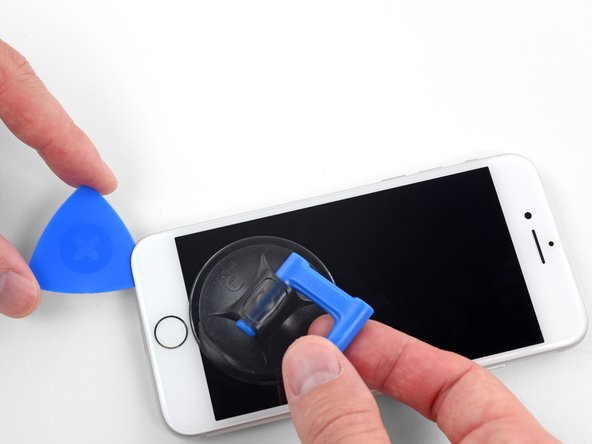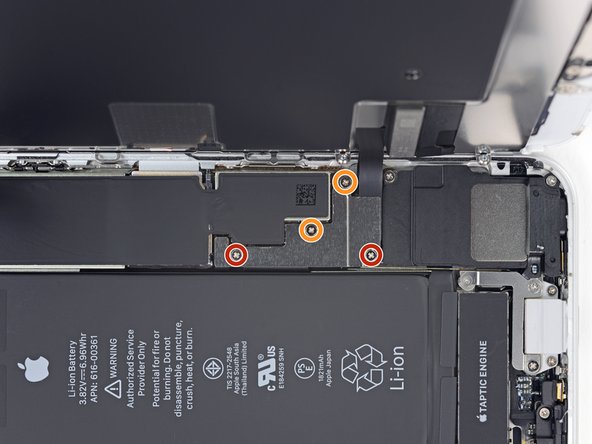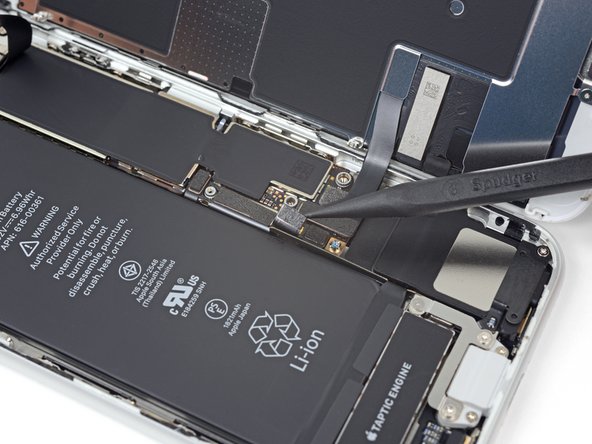iPhone SE 2020 Home/Touch ID Sensor Replacement
Duration: 45 minutes
Steps: 27 Steps
Heads up: most replacement home buttons just don’t play nice right out of the box.
The home "button" on your iPhone SE 2020 is actually a cool solid-state sensor, complete with Touch ID (fingerprint recognition) goodness! But here's the catch: most replacement buttons out there just won't cut it, so make sure to double-check before diving in. Your original home button is like a special snowflake, uniquely paired to your device's logic board right at the factory. Without Apple's secret calibration magic, even a genuine replacement from another iPhone won’t do the trick. If your home button is on the fritz, consider installing a universal-style button made just for this purpose. Just a heads-up, these replacements will work only as a button, and Touch ID will be taking a vacation. If you're just swapping out a broken screen, you can follow this guide to safely remove and transfer your original home button to a new screen, keeping all its functions—including Touch ID—intact. To make sure you don’t accidentally stress or tear those delicate display cables, it’s best to completely detach the display assembly before tackling the home/Touch ID sensor. But if you’re feeling adventurous, you can skip the display assembly section and head straight to the home/Touch ID sensor part!
Step 1
Hey there! Before diving in, make sure your iPhone battery is below 25%. A fully charged lithium-ion battery can be a bit of a drama queen and might set off fireworks if accidentally punctured.
And don't forget to power off your iPhone before you start taking things apart. Safety first, right?
Cracking open your iPhone’s display means those waterproof seals are going to take a hit. If you’ve got new seals, great—get them ready for action. If not, keep your phone far away from liquids when you put it back together.
- Start by unscrewing the two 3.5 mm pentalobe screws found along the bottom edge of your iPhone. Ready, steady, unscrew!
Step 2
Go easy with the opening pick! If you push it in too far, your device might not appreciate the surprise. Mark your pick so you know when to stop.
Want to be extra precise? Mark the other corners with your preferred measurements—style points included.
Another trick: tape a coin 3 mm from the tip of your pick for a handy depth guide.
- Grab your opening pick and measure about 3 mm from the tip. Mark that spot with a permanent marker so you know exactly where to start. A little prep goes a long way!
Step 3
Ready to see the Anti-Clamp in action? The next three steps walk you through using this handy tool to make opening your device a breeze. No Anti-Clamp? No worries—just skip ahead three steps for another method.
Want the full lowdown on mastering the Anti-Clamp? Check out our detailed guide.
If your iPhone feels like it's been greased up for a slip-n-slide and the Anti-Clamp can’t get a grip, slap on some tape to roughen up the surface and you’re good to go.
- Pull the blue handle backward to release the Anti-Clamp's arms.
- Slide the arms onto either the left or right side of your iPhone.
- Place the suction cups near the bottom edge of the iPhone, just above the home button—one on the front, the other on the back.
- Press the cups together to create a good seal and suction on the area.
Step 4
- Slide that blue handle forward to lock those arms in place—secure and ready!
- Give the handle a full spin clockwise, or keep turning until you see the cups start to stretch.
- Keep an eye on those suction cups—make sure they're lined up with each other. If they start drifting apart, loosen them just a bit and realign the arms.
Step 5
Go slow—just a quarter turn at a time, then pause for a minute before the next twist. Let the Anti-Clamp and a little patience do the heavy lifting!
A hair dryer, heat gun, or hot plate can work here, but don’t get carried away—too much heat can mess up your screen or battery, so keep it chill.
If the Anti-Clamp isn’t giving you enough space, warm things up a bit more and give the handle a little twist.
- Warm up your iOpener and slide it through the arms of the Anti-Clamp—like threading a scarf through the sleeves of your favorite jacket.
- Fold that iOpener so it cozies up to the bottom edge of your iPhone.
- Let things chill for a minute—this gives the sticky stuff a chance to loosen up and create a little gap.
- Slip an opening pick into that gap. Like a pro.
- Go ahead and skip the next three steps. You’ve got this!
Tools Used
Step 6
The next three steps will guide you on how to gently separate the screen using a trusty suction cup.
- Give the lower edge of your iPhone a little warmth to help loosen up the adhesive. This will make it much easier to open up!
- Grab a hairdryer or your trusty iOpener and apply it to the lower edge of the phone for about 90 seconds. This should soften the adhesive underneath, making things smoother for the next step.
Tools Used
Step 7
Make sure the suction cup steers clear of the home button—if it overlaps, it won’t stick properly to the front glass, and we can’t have that!
- Stick a suction cup on the lower section of the front panel, just above the home button. You're one step closer to getting inside your device!
Step 8
The screen is held on by some seriously tough watertight adhesive, so getting that first little gap open takes a good amount of elbow grease. If it’s being stubborn, try warming it up a bit more and gently rocking the screen back and forth to soften the glue until you’ve got enough space to slide your tool in.
- Grab the suction cup and pull up steadily with some solid pressure to gently loosen the screen from the frame.
- Slide an opening pick into the new gap you made to start the separation.
Step 9
Don't force the top edge of the display away from the rear case! It's secured with plastic clips that could snap. Take it slow and steady!
- Take your opening pick for a little adventure along the left edge of the phone—start down near the bottom and cruise up toward those volume buttons and silent switch, breaking up the sticky stuff holding the display.
- Pause your pick’s journey near the top left corner—don’t go all the way just yet.
Step 10
Heads up! There are some super delicate cables running along the right edge of your iPhone. Keep your pick away from this area to avoid any unwanted cable chaos.
Step 11
Keep your pick insertion shallow—no deeper than 3 mm—to avoid messing up the display cables.
- Pop your tool back in at the bottom right corner of the iPhone, then glide it smoothly around the corner and slide it up the right edge to loosen that stubborn adhesive.
Step 12
Keep that display at a comfy angle—no more than 15º! Going beyond that might just lead to some unhappy ribbon cables, and we wouldn’t want that.
- Give the suction cup a gentle tug to lift the bottom edge of the display. You got this!
- Now, pull on that little nub on the suction cup to pop it off the front panel. Easy peasy!
Step 13
- Gently slide an opening pick under the display at the top left corner and glide it along the top edge of the phone to break free the last bit of adhesive. You're almost there!
Step 14
- Gently nudge the display assembly downwards, away from the top edge of the phone, to pop those little clips free from their cozy home in the rear case.
Step 15
Hold your horses! Don't go trying to completely detach the display just yet; there are some delicate ribbon cables still holding hands with the iPhone's logic board.
- Gently lift the iPhone's display from the left side, just like opening a book. Think of it as flipping open your favorite page, but with a bit of tech magic.
- Once it's open, lean the display against something sturdy to keep it from falling while you work. A little support goes a long way!
Step 16
- Unscrew the four Phillips screws that are holding down the lower display cable bracket on the logic board. Here's the lineup:
- Keep your screws organized—mixing them up could spell trouble for your device when you put it all back together.
- Lift off the bracket.
- You’ll find two 1.3 mm screws and two 2.8 mm screws in the mix.
Step 17
- Grab your trusty spudger and gently pop the battery connector out of its spot on the logic board. No need for brute force—just a little nudge will do!
- Tilt the battery connector cable away from the logic board so it doesn't sneak back and power up your phone while you're working. Safety first, and you're crushing it!
Tools Used
Step 18
- Take your spudger and gently pop out the lower display connector—think of it like unplugging a tiny Lego brick.
- When snapping the connector back in, press down one end till you hear a click, then do the same on the other side. Skip pressing in the middle! A crooked connector can bend and cause lasting damage, so line it up carefully.
Tools Used
Step 19
- Grab your spudger and gently use its point to disconnect that second lower display cable. Easy peasy!
Tools Used
Step 20
- Unscrew the three tiny 1.3 mm Phillips screws holding down the bracket over the front panel sensor assembly connector.
- Lift that bracket off and set it aside.
Step 21
- Gently use the spudger's pointy end to disconnect the front panel sensor assembly connector. You've got this!
Tools Used
Step 22
- Take off the display assembly carefully.
- When putting it back together, take a moment here if you want to swap out the adhesive around the edges of the display.
Step 23
Start by removing this screw first. If you go for the 1.3mm screws before this one, you might accidentally bend the home button bracket—let’s keep it happy and safe!
- First, let's get those four Y000 screws out of the way that are holding the bracket over the home/Touch ID sensor. You got this!
- Now, gently take off that bracket.
- When you're putting everything back together, just a friendly reminder: don't go overboard tightening those screws, or your home button might throw a little tantrum.
- One 1.2 mm screw
- Three 1.3 mm screws
Step 24
If the whole connector starts to lift up without coming apart, gently press down on the cable at the top edge of the connector using the flat end of your spudger, while carefully prying up the left edge. Take it easy—damaging the cable or connector here will knock out the sensor for good.
- Grab your trusty opening tool and gently pop it under the left side of the home button cable connector—it’ll lift right out of its socket. Easy does it!
Tools Used
Step 25
Keep the display warm, not scorching—think cozy, not crispy.
A little heat around the home/Touch ID sensor does wonders for loosening up that stubborn adhesive, making the cable way easier to handle.
- Turn the display assembly upside down. Grab a hairdryer or whip up an iOpener and warm up the lower edge of the display for around 90 seconds to gently loosen that stubborn adhesive underneath.
Tools Used
Step 26
- Grab an opening pick and gently nudge it to loosen the adhesive that's keeping the home/Touch ID sensor cable snug against the back of the display panel. Take your time and be careful—this part's all about finesse!
Step 27
- Check your new replacement part against the original—sometimes you’ll need to move over leftover bits or peel off adhesive liners before popping it in place.
- To put your device back together, just rewind the steps you followed earlier.
- Got some old tech lying around? Take it to an R2 or e-Stewards certified recycler to keep things green.
- If things didn’t go perfectly, don’t stress! Try some basic troubleshooting or swing by our iPhone SE 2020 forum for tips. And if you’re really stuck, you can always schedule a repair.


































































